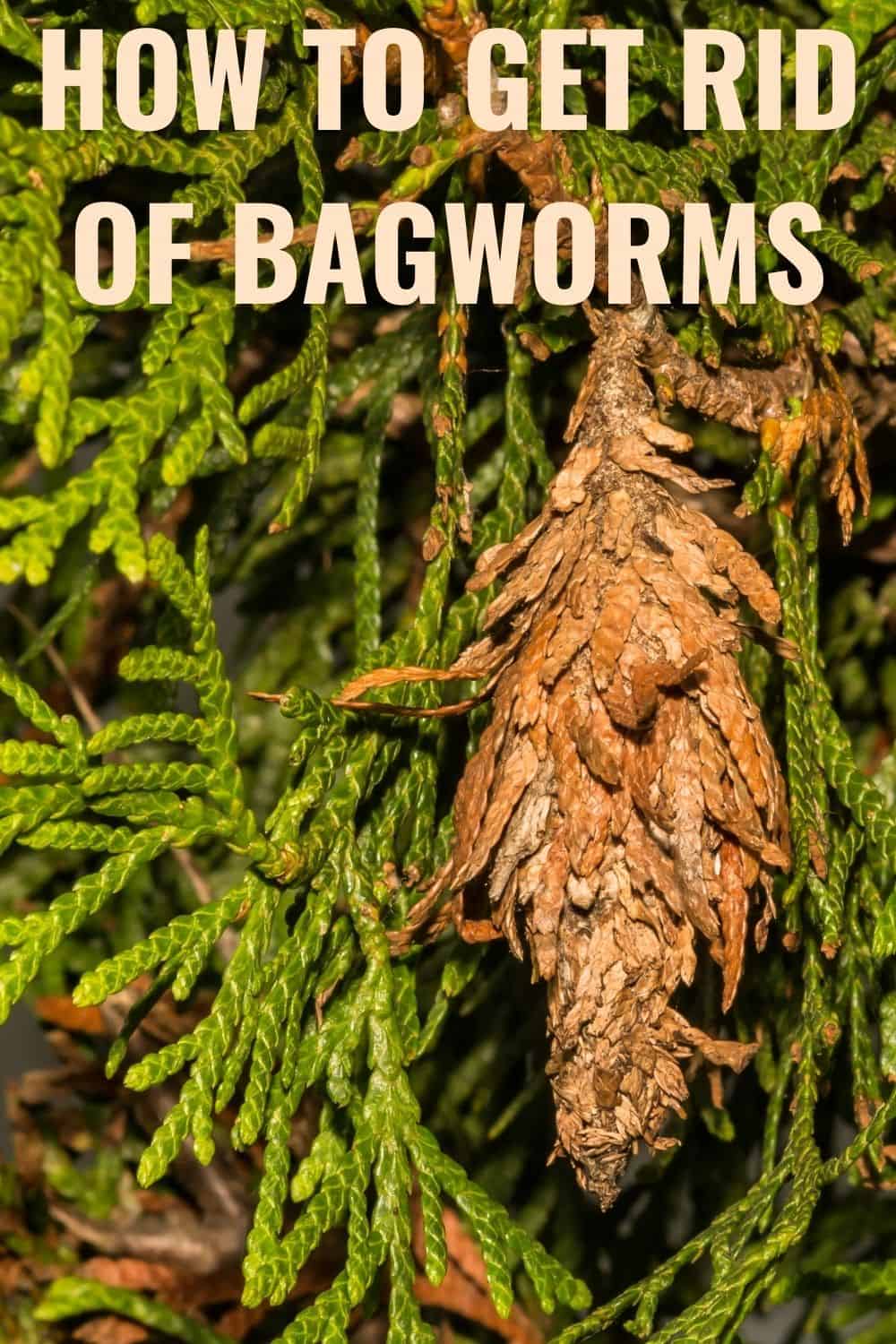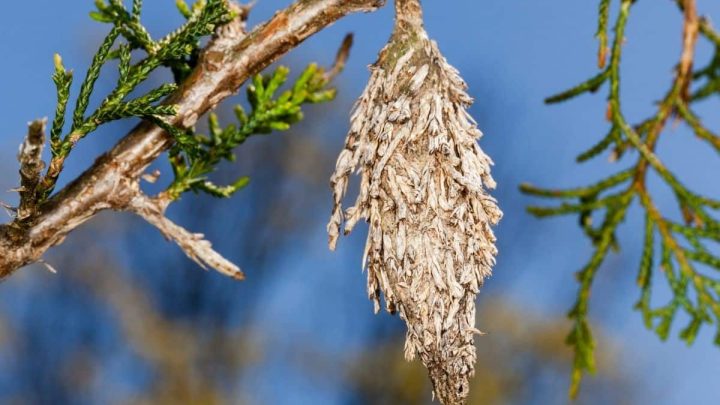Bagworms are known to attack a great variety of evergreen trees: in fact, over 120 different species of them. The moths and their caterpillars can do a lot of damage in a short period of time. The following is going to help in understanding how to get rid of bagworms.
These pests not only cause damage to evergreen but also to the leaves of other trees during the wintertime. They will chew tiny holes into the leaves of deciduous trees and create defoliation to occur. Applying certain insecticides can help you get rid of bagworms if you catch these pests while the larva is young. Otherwise, we have found some helpful hints to help you get rid of bagworms.
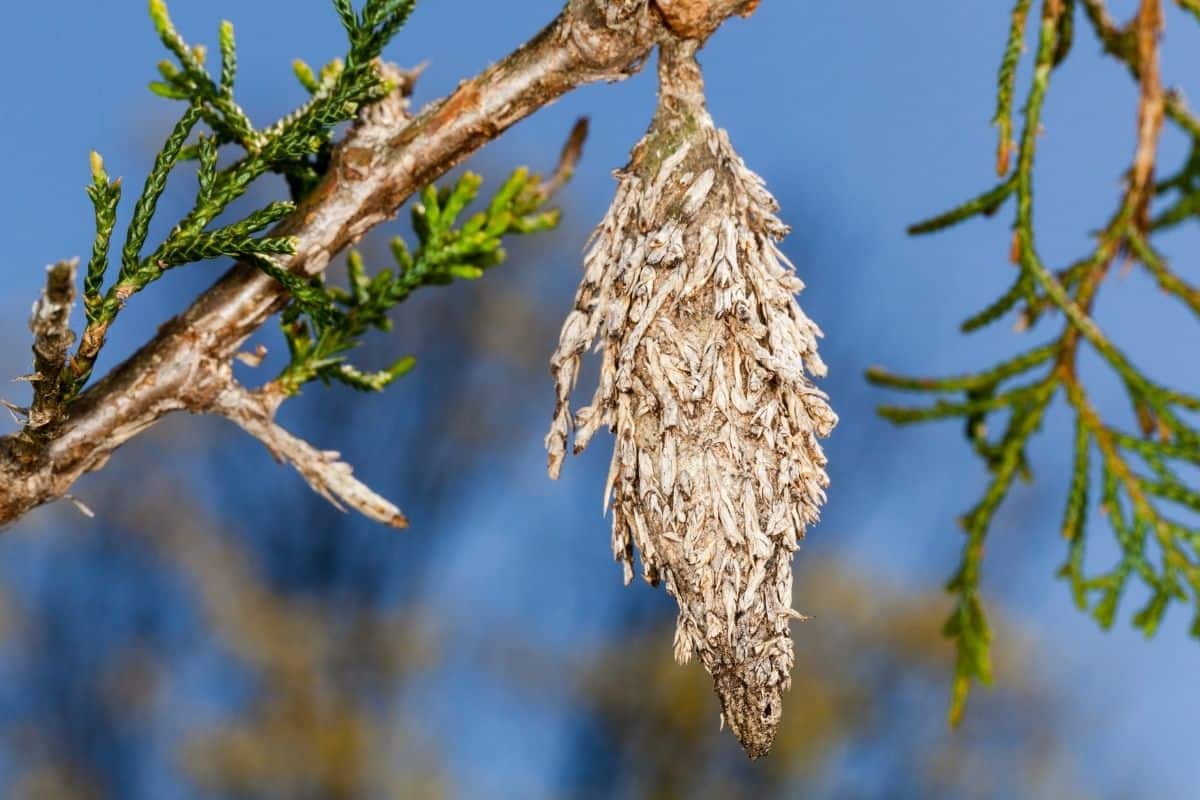
How To Identify Bagworms
First, we need to figure out how to spot the signs of bagworms in trees and shrubs. Bagworms, Thyridopteryx ephemeraeformis, are found throughout most of North America. You probably won’t come across any bagworms themselves when you notice an infestation, as the 2-inch, brown, spindle-like bags they create will be the most visible.
You could mistake them for pine cones if you weren’t looking hard enough, as these buggers camouflage well.
The life cycle of bagworms
Bagworms are actually just the caterpillar stage of moths.
In the fall, these bags are filled with hundreds of bagworm eggs. Bagworm eggs hatch in the late spring, early summer, and grow throughout the summer, making late summer and early fall the easiest time to see a physical representation of the infestation.
The bagworms eat the leaves, needles, twigs, and bark of the trees to create the materials needed for their spindly cocoons.
In the late summer, the males fly to the female’s bags and impregnate them, refilling the bags with eggs.
Each female can lay up to a thousand eggs. Ouch! That is a lot of moths and caterpillars eating your trees.
Appearance of bagworms
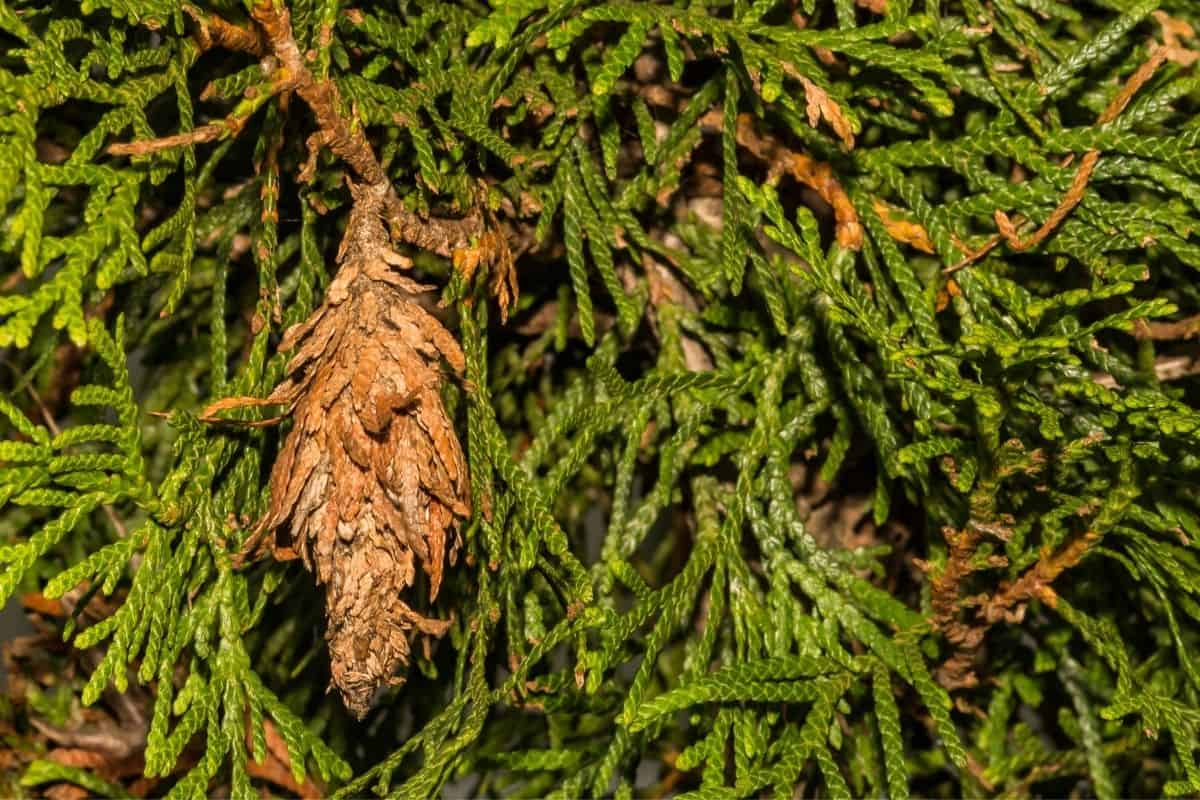
These black and brown caterpillars are at liberty to move and can carry their bags with them, actually using their silk as a parachute to jump from branch to branch. And the bags grow larger as the bagworms get bigger. Their silk is incredibly strong and makes for even more trouble in getting the bagworms off the trees for good.
However, the biggest problem with these bags they create is that they are made of interwoven leaves and other materials the bagworms harvest from the host’s plants, aka our trees and gardens. They have a parasitic relationship with plants, taking too much from their host and giving nothing back.
What Bagworm Damage Looks Like
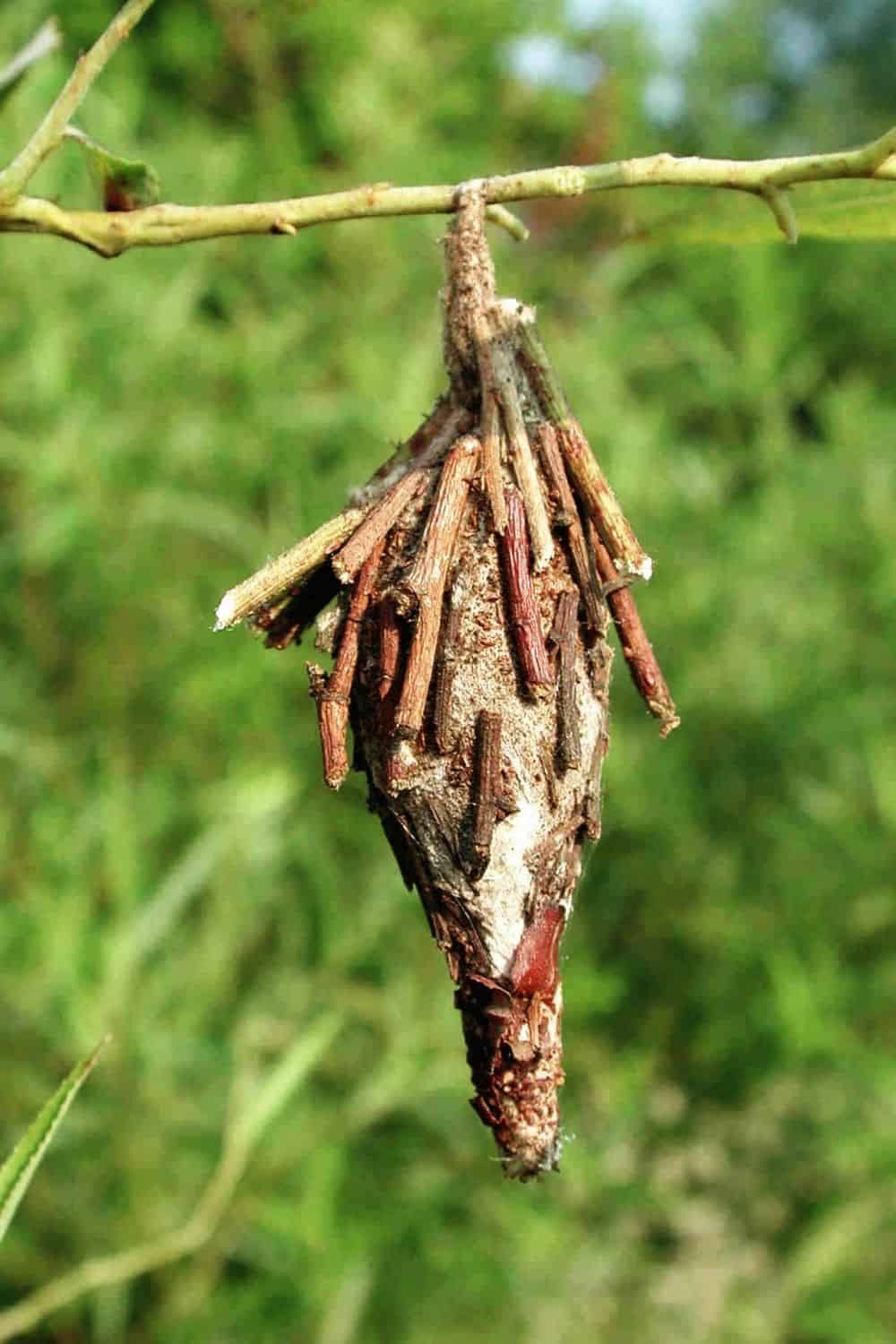
I was one of the lucky ones, noticing the infestation of bagworms before any true harm was done to my plants. Once bagworms get started, they can cause some real damage.
The most important part of stopping a bagworm infestation from getting worse is to get rid of them immediately. Unfortunately, because their bags camouflage so well into trees, many folks don’t realize they have a bagworm infestation until it’s far too late.
The first indicator of damage from bagworms would be a change in the color of the tree or bush. The leaves or needles would become pale or brown. A severe infestation of these pests could cause your trees to be stripped of all their needles, leaves, pinecones, branches, and unable to grow them back.
Of course, another sign of an infestation would be the cocoons or bags hanging from the trees. The caterpillar creates a cocoon from the silk it produces with tidbits of leaves and twigs from the bush or tree that is serving as a host. The bags are roughly 1 to 2 inches in length.
The cocoons are similar to the ornaments on your Christmas trees with the exception these contain moth larvae. This is not a pleasant thought of having in your home; therefore, check your live Christmas trees to make sure you are not bringing these into your home during the Holiday season.
How To Get Rid Of Bagworms
When I began searching how to remove these bagworms from my precious pines, the unanimous answer for the actual removal of the bagworms didn’t excite me.
1. Prevention
The best way to combat bagworm infestation is prevention. Pruning the limbs and raking the straw away from the tree’s base will help in the prevention of some of the parasites such as bagworms or webworms. Maintaining healthy soil and trees will also help in prevention.
2. Remove by hand
The easiest and most effective way to remove them is by simply picking them off the trees with your hands and soaking them in a bucket of water. But in order to protect my hands, I found a pair of trusted gardening gloves and (cautiously, of course) yanked those bagworms off my trees.
Birds do eat the caterpillars, but I just don’t trust the birds will get them all. Careful inspection of each tree is best to prevent an infestation in the future.
3. Pesticide spray
It’s also suggested to spray pesticides at the same time, in case you’ve missed any eggs or caterpillars (it’s easy to mistake bags on the ground for pine cones).
While I prefer a natural method to deal with all pests in my garden, if your infestation is severe, you might want to consider using chemicals that are tested and safe for consumer use. In the long run, it might be better for your garden’s health.
If you decide to use a pesticide, make sure to do your research on it.
The easiest way to kill bagworms is to spray an ingestible insecticide while the worms are feeding. The best time to spray is when the worms are young, which is sometimes in late May through the middle of June.
Some examples of ingestible insecticides:
For general preventive measures, you can continue to spray in the late spring, ensuring that any bagworms that hatch won’t get a chance to start devouring your trees.
Many of these insecticides can be harmful to other insects such as honey bees so read the labels and heed all the warnings before using these.
Here’s a list of items to use for in-home remedies for the control of the bagworms:
- Dawn Dish soap
- Vinegar
- Neem
- Bacillus thuringiensis var. kurstaki (Btk), a natural soil
- Diatomaceous Earth
- Garlic
- Chili Pepper
- Citrus
- Wormwood
- Molasses
- Tomato Leaves
4. Predators
The male bagworms are able to fly but they frequently hang out at the bottom of the tree. This fact makes the male vulnerable to attacks from predators.
Predatory wasp
The two most common groups of insect predators are Chirotic Thyridopteryx and Itoplectic Conquistor also known as the Predatory Wasp. These tiny insects don’t generally sting humans.
These wasps can be attracted by making sure that your landscape provides a steady supply of nectar. Start with planting a strip at least 3 feet wide on the sunny side of your treeline area of nectar-rich perennials. Mix and match for color and size to create a beautiful area for bees and wasps to collect nectar and bagworms.
- Bellflower (Campanula)
- Candytuft (Iberis)
- Carnation (Dianthus)
- Common houseleek (Sempervivum tectorum)
- Common lady’s mantle (Alchemilla vulgaris)
- Coneflowers (Rudbeckia)
- Columbine (Aquilegia)
- Cranesbill (Geranium)
- Daisy (Leucanthemum)
- Daylily (Hemerocallis)
- Golden alyssum (Alyssum saxatile)
- Hyssops (Agastache)
- Mountain Mint (Pycnanthemum)
- Lilac or purple rock cress (Aubrieta deltoidea)
- Lily (Lilium)
- Lily of the valley (Convallaria majalis)
- Larkspur (Delphinium)
- Phlox (Polemoniaceae)
- Primula (P. vulgaris)
- Peony (Paeonia)
- Purple coneflower (Echinacea purpurea)
- Rice button aster or bushy aster (Symphyotrichum dumosum)
- Rockfoils (Saxifraga)
- Speedwell (Veronica)
- Showy stonecrop or ice plant (Hylotelephium spectabile)
- Stonecrop (Sedum)
- Thimbleweed or windflower (Anemone hupehensis)
- Yarrow (Achillea millefolium)
Birds
The same flowers will attract predatory birds, such as sparrows, woodpeckers, and sapsuckers, that will feast on the caterpillars. You can strengthen this by adding bird feeders and birdbaths to entice the birds to this area.
5. Early detection is key
Other than spraying pesticides, the only other true form of prevention is surveying the area.
I recommend taking a walk amongst your thicker settled trees and shrubbery at the beginning of each season, not only is it a way to embrace how beautifully each season is reflected in your green space, but you can also look for signs of bagworms to ensure early detection and eradication!
DIY Natural Spray Solutions For Controlling Bagworms
I want to share a few do-it-yourself recipes for sprays that will not be harmful to other plants, animals, or your family.
Dish soap spray solution recipe
Surprisingly, some dish soap solutions will offer the same results as the pricy chemical sprays.
Follow these four easy steps to a safe alternative for ridding yourself of these pesky insects.
- Step 1: Pour 2 teaspoons of dish soap into 1 gallon of water. Thoroughly mix.
- Step 2: Fill your garden sprayer with the soap solution. Replace the cover. Then pump it up to build the pressure to a good spraying pressure that comes out of the nozzle.
- Step 3: Then you will need a long solid stick that you have whittled the end to a point. You will use this stick to puncture the bagworm’s bags. The stick needs to be long enough to reach the bags on the highest limbs of the trees.
- Step 4: With the pointy end of the stick, make a hole into the bagworm bag, so you can spray the dish soap solution inside the bag, coating inside the bag. Repeat this process until you are sure you have soaked every cocoon.
Irish spring soap repellent
That’s right! Irish Spring soap will repel many insects and animals. We, humans, tend to like the scent of soap, but the animals and insects find it repulsive. Follow these 4 steps below to create your own repellent.
- Step 1: Cut the bar of Irish Spring Soap into 4-6 pieces.
- Step 2: Use an old sock or cloth to cut up into smaller pieces to create a bag to hold the soap piece.
- Step 3: Place the soap pieces in the cloth and tie.
- Step 4: There are two ways you can do this. First, you can hang the soap bags from the branches of your trees. The second way, you can nail the soap bags to wooden stakes, which are then hammered into the ground surrounding the tree.
Note: I would grate some of the Irish Spring soap and sprinkle it heavily on the ground surrounding the tree too.
A few more frequently asked questions
Are bagworms harmful?
The larvae of the Bagworm feed and grow on bushes and trees. This definitely damages the tree. Although these caterpillars pose no threat to human health, they do pose costly damage to your landscape and plants.
Can a tree recover from bagworms?
The injury to cone-bearing seed plants will take longer to recover and heal because so many of them don’t produce new growth from the old wood. Recuperation occurs as the plant continues to grow from its tips, and will eventually show new growth that will cover the bagworm damage. It often takes years for them to regain their appearance.
When should you spray bagworms?
If you decide to spray, the best time is in May-June. You will want to spray the trees just at the time the eggs are hatching or when the small larvae are starting to appear.
The bagworm’s egg spends winter enclosed in the silk pod just hanging around in the trees from the previous year’s infestation. These eggs will start to hatch in late May and past the middle of June.
Wrapping it up
Bagworms may not seem like much of a threat to you, but if left to munch upon your tree’s leaves and limbs, they will cause permanent damage. I’m thankful I caught my infestation before things escalated. It’s important to inspect your trees for these spindle-like bags, and no matter what time of year you find them, eradicate those bagworms immediately. The best way of removal is by handpicking the bags and placing them in warm soapy water, then disposing of them with your garbage.
I would love to hear from you if you have any questions or need some help with a bad case of bagworms bugging your garden. Please feel free to leave a comment.
